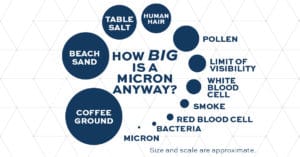
When researching electronics enclosures, organizations will see the terms “micron” and “submicronic” used in regard to the filtration system.
The terms obviously allude to how small of a particle the filter will stop, as well as how big of a particle it will let through. But, what exactly is a micron anyway? And along with that, what particles are “micronic” in size and what are “submicronic”?
That’s what we’re here to answer today. Read on to learn more.
Micron Explained
Micron (μm) is short for micrometer, a measurement that means one-millionth of a meter (.001 mm) or .00003937” in the imperial system. To put it into perspective even more, 40-50 micron objects are the smallest things that can be seen with the naked eye.
In regard to dust filters, “micron” and “submicronic” refer to how small of a particulate the filter will be able to stop. Most single dust particles are no bigger than 5 microns in size, so a filter that stops particulates down to 1 micron in size will be able to catch much of the airborne dust.
DustShield filters, though, are designed to stop particulates that can be as small as .1 micron, which would ensure event smaller particulates like pet dander (.5-100 μm) and wood smoke (.2-3 μm) are stopped as well.
How It Works
DustShield filters are designed with two layers–a carbon prefilter and a blended synthetic filter. The carbon prefilter has more surface area and acts like a sponge, allowing the particulates to adhere to the surface as air passes through. The blended synthetic filter traps most of the remaining particulates down to .1 micron in size.
Simply put, large particulates get stuck on the prefilter, smaller particulates get stuck on the main filter and nothing gets stuck on the machine. That’s how organizations can keep their electronics running smooth for a long time.
Maintenance
Filters only work as long as they’re clean. Organizations should ensure they’re replacing their filters on a monthly or bi-monthly basis, depending on the harshness of the environment. A blocked filter won’t let enough air into an enclosure, making it hard to cool the machine.
At DustShield, we custom-built enclosures and filters to protect valuable electronics in the harshest environments. From warehouses to production floors and more, a DustShield enclosure solution will filter out particulates down to .1 micron in size, keeping your equipment safe and running smoothly longer. If you’re interested in learning more, contact our enclosure specialists at 417.736.3746 or sales1@amprod.us now.

